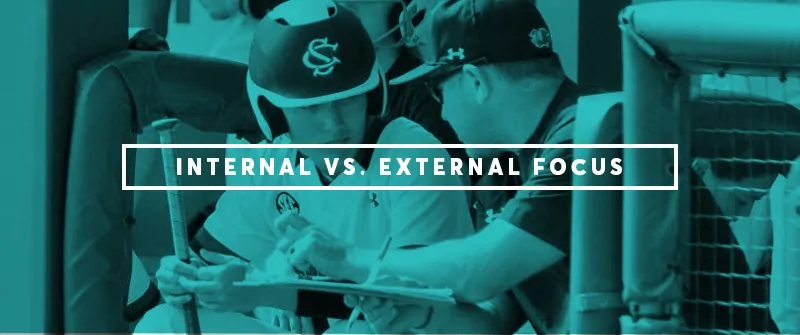Internal vs. External Focus for Baseball and Softball Hitters

Table of Contents
As hitting coaches, our primary role is to serve as a translator for our players. We have to understand complex scientific concepts about how the body moves during the swing and design drills (and cues within those drills) that our hitters can actually put into practice.
In fact, communicating effectively with athletes is such an important aspect of athletic training that scholars in fields like sports psychology and sports performance have researched the specific types of cues and language that are most impactful.
And one thing the research shows is that people tend to learn new motor skills more efficiently when they have an external focus rather than an internal focus.
As a hitting coach, understanding what this means — and why one type of focus is more effective than the other — will empower you to give your players feedback that helps them learn new movements and make changes to their swing as quickly as possible.
The Difference Between Internal Focus and External Focus
The terms internal focus and external focus describe the attentional focus of an athlete. In other words, they explain what the athlete is thinking about when he or she is trying to perform an action.
Internal focus means that the athlete is thinking about something inside their own body, such as a muscle or a bone. External focus means that the athlete is thinking about something outside their own body, such as their back pocket.
That’s the example Coach Lisle uses in the video below, in which he explains that the difference between internal and external focus is as simple as saying “show your back pocket to the pitcher” rather than “internally rotate your front hip.” Both cues describe the same movement, but the external cue places the hitter’s attentional focus on an object other than their own body.
The Soviet neurophysiologist Nicolai Bernstein, who was a pioneer in the field of motor learning, argued that the neurological processes that govern how the body moves are “delegated to subordinate levels of the nervous system, where control is less conscious.”
What that means in plain English is that subconscious thinking about a particular movement may produce better results than a conscious focus on that same movement.
In the book Nonlinear Pedagogy in Skill Acquisition, Chow et al. expound on that idea, writing that, “[…] if the movement occurs more consciously, the upper levels of the central nervous system are more involved and this can lead to undesirable breakdown of the movement.”
Chances are that you’ve personally felt this phenomenon in action when working on your golf swing, learning a new dance move, or doing any other activity that required you to move your body in an unfamiliar way; it’s a lot harder to execute a sequence of movements when you’re consciously thinking about it.
Baseball and softball hitters know this intuitively: trying to think about swinging the bat is the surest way to make sure you never hit the ball. The swing only works when you relax and let your subconscious take over and run the show.
A Time and Place for Internal Focus
You may be wondering whether there’s any use for internal focus. Interestingly, a 2007 paper titled “Effects of Focus of Attention on Baseball Batting Performance in Players of Differing Skill Levels” found that beginning hitters who are just learning the absolute basics of the swing may benefit from internal instructions.
But for athletes who have a general understanding of the swing and have already developed the basic motor skills necessary to execute it, using external cues and focuses produced better results.
Applying the Concept to Baseball and Softball Players
What are some specific examples of internal and external focus cues for baseball and softball players?
Here are five of the most common areas that hitters work on, along with corresponding internal and external cues.
- Lack of downward shoulder movement during the load phase, which can cause a multitude of problems later in the swing. The correct movement looks similar to rocking a baby.
- Internal cue: “Front shoulder down, back shoulder up.”
- External cue: “Rock the baby”
- Internal rotation of the hips, which can help a hitter increase power because it essentially gives the hips a running start.
- Internal cue: “Internally rotate your hips.”
- External cue: “Take your belly button to the catcher,” or “turn your pocket to the pitcher.”
- Failing to keep the hands up and back during the stride is a common problem. Having a hitter activate their back arm scapula as they stride forward will help with correct this issue. When you shoot a bow and arrow, you have to pull back and turn on the scapula — it’s similar to hitting!
- Internal cue: “Activate your scapula.”
- External cue: “Shoot the bow and arrow.”
- Many hitters don’t turn their hips far enough. The belt buckle should be facing the pitcher before and/or at contact.
- Internal cue: “Rotate your hips more”
- External cue: “Show your belt buckle to the pitcher.”
- Keeping too much weight in the back foot at contact is another common flaw. We actually want the back foot to be weightless at contact. Having a hitter swing with their back foot coming up and over a line or paint stick will help teach the idea of releasing the back foot.
- Internal cue: “Release your back foot.”
- External cue: “Hop over the paint stick.”
Resources
- Coach Lisle and the Hitting Vault believe that the mental approach to hitting is extremely important. This article and video provide a few tips on coaching the psychological aspect of the game.
- In this graduate thesis, Alexander Kershner of the University of Kansas conducted research on baseball players to evaluate the effects of internal and external cues. 10 different metrics were calculated, including jump height, peak velocity, and peak force. Numbers were significantly higher (and the information was better retained) when external cues were used.
- This article synthesizes and analyzes a number of research studies conducted on internal vs external focus instructions. The article is aimed at tennis players, but there’s a lot of actionable information for hitting coaches that’s worth thinking about.
- In this article from Lower Extremity Review, Cary Groner provides some background on both internal and external learning and outlines some of the research conducted on the topic.
Frequently Asked Questions
When an athlete is trying to change or learn a movement, their attentional focus is essentially what they’re purposefully paying attention to. External focus and internal focus are the two kinds of attentional focus.
The term attentional field refers to everything you could possibly focus on. In other words, your senses (what you see, what you hear, what you feel, etc.) and physical and psychological responses (feelings, thoughts and emotions).
Intrinsic feedback is when you use your own senses and feelings to determine if you performed correctly. Extrinsic feedback is when that information is given from an outside/external source, whether that’s a person, data or video.
If you’re aiming to improve your focus to boost your athletic performance, here’s a simple five-step plan you can put into action:
1. Set specific goals.
2. Make a plan for how to improve in the areas needed to achieve your specific goals.
3. Track your progress.
4. Find the external cues that work and keep track of them.
5. Use mental imagery.
The Hitting Vault is the most popular, most trusted and highest rated online hitting community.
It was created to teach athletes how to move their body to unlock their most powerful swing. It’s designed to help coaches get optimal results from their athletes. Join and get access to over 100+ exclusive videos for members and step-by-step instruction so you’ll know exactly what to do next to unlock your power at the plate.



